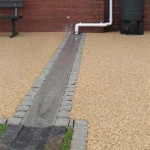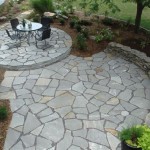How To Clean a Dirty Cement Patio
A cement patio, while durable and offering a versatile outdoor living space, is susceptible to accumulating dirt, grime, algae, mildew, and various stains. Regular cleaning and maintenance are essential to preserve its appearance and prevent deterioration. This article provides a comprehensive guide on effectively cleaning a dirty cement patio, covering various methods, tools, and cleaning solutions.
Assessing the Patio’s Condition and Necessary Supplies
Before initiating the cleaning process, a thorough assessment of the patio's condition is crucial. This involves identifying the types of stains present, the severity of the dirt buildup, and any pre-existing damage, such as cracks or chips. This assessment informs the selection of appropriate cleaning methods and solutions. For example, grease stains require a different approach than algae growth.
Subsequently, gather the necessary cleaning supplies and tools. The specific items required will depend on the chosen cleaning method, but a general list includes:
- A stiff-bristled broom for sweeping away loose debris.
- A garden hose with a spray nozzle for rinsing.
- A bucket for mixing cleaning solutions.
- A scrub brush, preferably with a long handle for reaching all areas.
- A pressure washer (optional, but highly effective for heavily soiled patios).
- Safety glasses and gloves to protect eyes and skin.
- Cleaning solutions, such as dish soap, oxygen bleach, trisodium phosphate (TSP), or commercial patio cleaners.
- A putty knife or scraper for removing stubborn debris.
Choosing the right cleaning solution is paramount. Consider the environmental impact and the type of stains being addressed. Always test the cleaning solution in an inconspicuous area first to ensure it does not damage or discolor the cement.
Basic Cleaning: Sweeping and Rinsing
The first step in cleaning any cement patio is to remove loose debris. This involves thoroughly sweeping the entire surface with a stiff-bristled broom. Pay close attention to corners, edges, and areas where leaves or other organic matter tend to accumulate. Removing this debris prevents it from interfering with the cleaning process and allows cleaning solutions to penetrate the surface more effectively.
After sweeping, rinse the patio with a garden hose to remove any remaining loose dirt and dust. A spray nozzle can be used to provide a more concentrated stream of water for dislodging stubborn particles. This initial rinse also helps to dampen the cement, which can improve the effectiveness of some cleaning solutions.
For lightly soiled patios, this sweeping and rinsing process may be sufficient to restore a clean appearance. However, for patios with more significant dirt buildup or staining, further cleaning methods are necessary.
Deep Cleaning Methods: Solutions and Techniques
Several deep cleaning methods can be employed to tackle more stubborn dirt and stains on a cement patio. The choice of method depends on the type and severity of the soiling.
Dish Soap and Water:
For general cleaning and light stains, a solution of dish soap and water can be effective. Mix a few tablespoons of dish soap in a bucket of warm water. Apply the solution to the patio surface and scrub thoroughly with a scrub brush. Allow the solution to sit for a few minutes to loosen the dirt, then rinse thoroughly with a garden hose. This method is generally safe for all types of cement and is environmentally friendly.
Oxygen Bleach:
Oxygen bleach (sodium percarbonate) is a safer and more environmentally friendly alternative to chlorine bleach. It is effective for removing organic stains such as algae, mildew, and leaf stains. Mix the oxygen bleach powder with warm water according to the manufacturer's instructions. Apply the solution to the patio surface and allow it to sit for 10-15 minutes. Scrub the surface with a scrub brush and then rinse thoroughly with a garden hose. Oxygen bleach is generally safe for colored concrete and will not discolor the cement.
Trisodium Phosphate (TSP):
Trisodium phosphate (TSP) is a powerful cleaning agent that is effective for removing grease, oil, and other stubborn stains. However, it is important to use TSP with caution, as it can be harmful to the environment and can irritate skin and eyes. Wear safety glasses and gloves when using TSP. Mix the TSP powder with warm water according to the manufacturer's instructions. Apply the solution to the patio surface and scrub thoroughly with a scrub brush. Allow the solution to sit for a few minutes to loosen the dirt, then rinse thoroughly with a garden hose. Because of environmental concerns and potential regulations, explore alternative cleaning agents when feasible.
Commercial Patio Cleaners:
A variety of commercial patio cleaners are available at hardware stores and home improvement centers. These cleaners are specifically formulated to remove dirt, stains, and algae from cement patios. Follow the manufacturer's instructions carefully when using commercial patio cleaners. Some cleaners may require dilution, while others can be applied directly to the surface. Always test the cleaner in an inconspicuous area first to ensure it does not damage or discolor the cement.
Pressure Washing:
A pressure washer is a powerful tool for cleaning heavily soiled cement patios. It uses high-pressure water to blast away dirt, grime, and stains. When using a pressure washer, it is important to use the correct nozzle and pressure setting to avoid damaging the cement. Start with a wide-fan nozzle and a low-pressure setting and gradually increase the pressure until the desired cleaning effect is achieved. Hold the nozzle at a consistent distance from the surface and use overlapping strokes to ensure even cleaning. Be cautious when pressure washing near delicate areas, such as plants or windows. Pressure washing can be an effective cleaning method, however, it's important to control the pressure directed at the concrete surface to prevent etching or damage.
Addressing Specific Stains
Certain stains on cement patios require specific treatment to remove effectively.
Oil and Grease Stains:
Oil and grease stains can be difficult to remove from cement patios. One effective method is to create a poultice using a mixture of baking soda and water. Apply the poultice to the stain and allow it to dry completely. The baking soda will absorb the oil and grease. Once the poultice is dry, scrape it off with a putty knife and rinse the area with water. Commercial degreasers are also available and can be effective for removing oil and grease stains.
Rust Stains:
Rust stains can be removed with a commercial rust remover or with a solution of oxalic acid. Follow the manufacturer's instructions carefully when using rust removers or oxalic acid. Always wear safety glasses and gloves when handling these chemicals. Apply the solution to the stain and allow it to sit for a few minutes. Scrub the area with a scrub brush and then rinse thoroughly with water. It is important to neutralize any remaining acid residue with a solution of baking soda and water after cleaning with oxalic acid.
Algae and Mildew Stains:
Algae and mildew stains are common on cement patios, especially in damp or shady areas. Oxygen bleach is an effective solution for removing these stains. Apply a solution of oxygen bleach and water to the affected area and allow it to sit for 10-15 minutes. Scrub the surface with a scrub brush and then rinse thoroughly with water. Preventative measures, such as ensuring proper drainage and trimming overhanging vegetation, can help to reduce the growth of algae and mildew.
Preventative Measures and Regular Maintenance
Preventing dirt and stains from accumulating on a cement patio is the best way to keep it clean and maintain its appearance. Regular sweeping and rinsing are essential for removing loose debris and preventing dirt from becoming embedded in the surface. Sealing the cement patio with a concrete sealant can also help to protect it from stains and water damage. Concrete sealants create a barrier that prevents liquids from penetrating the surface, making it easier to clean and maintain. Apply a concrete sealant according to the manufacturer's instructions, typically every one to two years.
Promptly clean up spills and stains to prevent them from setting in. Use mats or rugs in high-traffic areas to protect the cement from dirt and wear. Consider using outdoor furniture covers to protect furniture and the patio surface from the elements. Regularly inspect the patio for cracks or damage and repair them promptly to prevent further deterioration. Addressing minor issues early on can prevent them from escalating into more significant problems.
By implementing these preventative measures and following a regular cleaning schedule, a cement patio can be maintained in optimal condition, providing a beautiful and functional outdoor living space for years to come. The frequency of cleaning will depend on factors such as the patio's exposure to the elements, the amount of traffic it receives, and the surrounding environment. However, a consistent approach to cleaning and maintenance will significantly enhance the longevity and appearance of the cement patio.

How To Clean Concrete The Easy Way Porches Patios Driveways More Run Radiance

Best Way To Clean A Concrete Patio Chalking Up Success

The Easiest Way To Clean A Concrete Patio My Creative Days

Diy Miracle Concrete Patio Cleaner I Should Be Mopping The Floor

Diy Miracle Concrete Patio Cleaner I Should Be Mopping The Floor

6 Easy Ways To Clean Your Concrete Patio For Spring

Diy Miracle Concrete Patio Cleaner I Should Be Mopping The Floor

How To Clean A Sidewalk

How To Clean Concrete The Easy Way Porches Patios Driveways More Run Radiance

The Easiest Way To Clean A Concrete Patio My Creative Days
Related Posts








